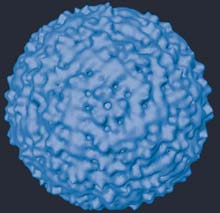Life Sciences and Chemistry
Articles and reports from the Life Sciences and chemistry area deal with applied and basic research into modern biology, chemistry and human medicine.
Valuable information can be found on a range of life sciences fields including bacteriology, biochemistry, bionics, bioinformatics, biophysics, biotechnology, genetics, geobotany, human biology, marine biology, microbiology, molecular biology, cellular biology, zoology, bioinorganic chemistry, microchemistry and environmental chemistry.

Pathways of emotion – from cortex to peripheral organs
Walking down a dark alley late at night is enough to give anyone the heebie-jeebies. Your heart starts racing, your palms get clammy and you get ready to run. Now researchers from Boston University have unravelled the neural pathways that transmit information about your surroundings to your organs, enabling them to respond appropriately.
The research, to be published on Friday in BMC Neuroscience, has shown that neurons originating in high-order brain structures transmit signals about the

Aging brain reduces ovulation
Dutch researcher Annelieke Franke has discovered that the aging of the brain adversely affects the fertility of female rats. The scientist suspects that her research will provide insights into fertility problems of women over the age of 30.
Franke studied relatively young subfertile rats. Although the pituitary gland and ovaries of these rats still functioned normally, their brains had already started to function differently. This led Franke to conclude that the ageing of the brain reduces f

Genes that regulate hearing link humans and fruit flies in new way
Fly genetics may increase understanding of human hearing disorders
Researchers at the University of Wisconsin Medical School have found genetic evidence linking humans and fruit flies in a new way: through their hearing. The link offers the future possibility that the insect’s auditory system may serve as a model for understanding human deafness and other hearing disorders.
The scientists found that a mutated fruit fly gene controlling hearing and the mutated human coun

Purdue team solves structure of West Nile virus
Purdue University biologists have determined the structure of the West Nile virus, a development that could greatly augment our understanding of the virus’ life cycle.
Using cryoelectron microscopy and advanced imaging techniques, the Purdue team has determined the orientation of the major surface proteins in a West Nile viral particle. Because these proteins are instrumental in allowing the virus to bind to and invade a host cell, the research could be a step forward in combating the

Gene expression tied to social behavior in honey bees
Genes and behavior go together in honey bees so strongly that an individual bee’s occupation can be predicted by knowing a profile of its gene expression in the brain, say researchers at the University of Illinois at Urbana-Champaign.
This strong relationship surfaced in a complex molecular study of 6,878 different genes replicated with 72 cDNA microarrays that captured the essence of brain gene activity within the natural world of the honey bee (Apis mellifera). Even though most of th

An efficient and simple method for varietal identification of the cherry tree
Professor Ana Wünsch Blanco has presented her PhD, at the Public University of Navarre, on the application of molecular technologies in the identification and enhancement of the cherry fruit tree.
The application of molecular technologies in the identification and enhancement of the cherry tree is not something new. In fact, the varietal identification of fruit species has been accompanied, in the past few years, by the appearance of DNA markers. This has enabled an investigation of the geno